Mycoplasma hyopneumoniae (M.hyopneumoniae) is one of the most important primary pathogens of the porcine respiratory system and is the causative agent of Enzootic pneumonia (EP) (Fraile et al., 2010). M.hyopneumoniae is also a major contributor to development of the Porcine Respiratory Disease Complex (PRDC) (Garcia-Morante et al., 2015). M.hyopneumoniae is widespread throughout the pig population and is endemic on most farms worldwide. Pneumonic lung lesions due to M.hyopneumoniae are commonly observed in the slaughterhouse, with average herd level prevalence reported as 24%, ranging up to 88% (Maes et al., 2001), demonstrating the large variability observed between units depending on individual farm situation. Co-infections are very important in respiratory disease, as interaction of multiple pathogens has been shown to increase the severity of clinical signs (Saade et al., 2020) and therefore the impact on performance. Enzootic pneumonia has a large economic impact on the pig industry, primarily due to the cost of treatment, reduced performance and increased mortality due to secondary infections (Holst et al., 2015). Therefore, implementation of control measures is extremely important to improve animal health and consequently productivity on farm. Management practices form an integral part of this control plan, including improved biosecurity and hygiene, which may be accompanied with vaccination. There are numerous vaccines available which vary in the vaccination schedule, but the ultimate goal should be reduction of lung lesions and performance losses due to M.hyopneumoniae.
Christina Gale, BSc, Swine Marketing Manager, Eduardo Velazquez, MRCVS, Swine Veterinary Service Manager and Emma Pattison, BSc, Swine Field and Vaccination Services Manager, Ceva Animal Health, UK
The pathogen
Mycoplasma hyopneumoniae is 200-500nm in size and requires complex media and aerobic and microaerophilic conditions to be cultured. Infection with M.hyopneumoniae occurs via inhalation of infected aerosols or via direct contact with infected animals. The pathogen establishes itself in the respiratory tract, attaching to the ciliated cells of the tracheal, bronchial and bronchiolar epithelium. Once in the respiratory tract, it can persist for weeks to months and causes pathological changes in the lungs. Lesions are thought to form in the lobes of the lung due to lack of normal clearance of secretory products from the respiratory system, due to infection of the ciliated epithelium (Taylor, 1995). Early lesions are observed as small dark red areas in the anterior lobes, which enlarge over time and after a few weeks lose their red colour and become more pink (Figure 1). Lesions resolve after 12 to 14 weeks with formation of interlobular fissures (Maes et al., 2008). This is important to note, as infections early in production may be resolved once the animal reaches the slaughterhouse, so any scarring (Figure 2) should be noted as losses may still have occurred during the growing and finishing stages.
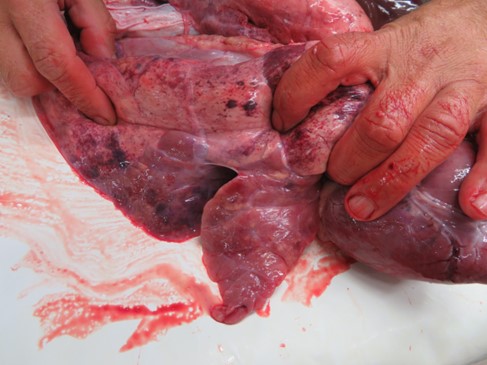
Figure 1 - Pneumonic lung lesions caused by infection with M.hyopneumoniae
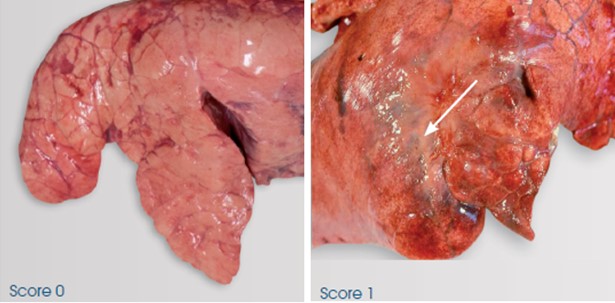
Figure 2 - Scarring of lobes (score 1) due to recovery of lung lesions caused by infection with M.hyopneumoniae
Histologically, inflammation occurs and neutrophils can accumulate in the airways and bronchioles. Lymphocytes and macrophages will also be present 5 days after infection, followed by presence of large mononuclear cells, polymorphs, lymphocytes and plasma cells in the alveoli from day 7 (Taylor, 1995). Immunoglobulin IgA forms in tracheal mucosa so may be detectable from day 30 on diagnostic testing of secretions, and IgG may also be present at a slightly later stage.
Clinical signs
Enzootic pneumonia can clinically be acute or chronic in its form which have different clinical presentations of disease. Pigs of all ages can be affected in the acute form and most likely will experience pyrexia, anorexia and respiratory distress, usually accompanied with a distinct cough (Taylor, 1995). Whereas, in the chronic form, few clinical signs may be observed, particularly in young growing pigs, where diarrhoea and a dry cough may be the only visible signs if present. Later in production, this cough may become a barking cough in the finishing house and what may be most apparent is the variation in size of pen mates, indicating performance has been compromised in some animals.
Diagnosis
Diagnosis can be carried out by M.hyopneumoniae specific seroconversion or laryngeal swabs tested by PCR (Pieters et al., 2017). Examination of the lungs at slaughter can also be useful to report presence of pneumonic lesions, characterised by consolidated areas especially in the cranial lobes (Maes et al., 2001). Seasonal patterns are often observed with M.hyopneumoniae, with lung lesions prevalence and severity increasing following the winter months. This was demonstrated by Ostanello et al. (2007) where, as scored using the Madec and Kobisch method (1982), mean lung lesion score was significantly increased in batches of animals raised in the winter months (October-March) compared to the summer months (April-September), with scores of 2.33 and 1.81 respectively. Decreased growth rate and feed conversion ratio (FCR) may also be observed, typically with no or low mortality (Sibila et al., 2009).
Coinfections
Mycoplasma hyopneumoniae is a primary pathogen and one of the main ones responsible for the development of PRDC. The pathogen modifies the immune response and facilitates the expression of co-infections. It is described as an inhibitor of macrophage phagocytic activity, which may explain the chronicity of M.hyopneumoniae infections and the greater host susceptibility to other pathogens (Figure 3 and 4)(Saade et al., 2020).
Co-infections can occur with both viral and bacterial diseases. Regarding viruses, it is important to mention three very important diseases affecting the swine herd globally; Porcine Respiratory and Reproductive Syndrome (PRRS), Swine Influenza Virus (SIV) and Porcine Circovirus (PCV2). M.hyopneumoniae potentiates PRRS induced lung lesions but not inversely. The bacteria facilitates the replication of the virus but PRRS does not increase the nasal excretion of M.hyopneumoniae. Therefore vaccination of pigs against M.hyopneumoniae is a priority if a farm is co-infected with both PRRS and M.hyopneumoniae (Chae, 2016)
In the case of co-infection with SIV, the lung lesions of co-infected pigs are more severe than that of pigs inoculated against M.hyopneumoniae only, even if the SIV strain is only slightly pathogenic (Yazawa, 2004). If co-infection occurs with PCV2, M.hyopneumoniae facilitates the replication in vitro of the virus, which could be up to 350% according to different strains of M.hyopneumoniae (Wang et al., 2016). Opriessnig et al. (2004) indicated that M.hyopneumoniae potentiates the severity of PCV2-associated lung and lymphoid lesions, increases the amount and prolongs the presence of PCV2- antigen, and increases the incidence of Post-weaning Multisystemic Wasting Syndrome in pigs.
In relation to bacterial co-infections, the importance of M.hyopneumoniae is as crucial as with viruses. In pigs simultaneously infected with M.hyopneumoniae and Actinobacillus pleuropnuemoniae (App), clinical signs and lung lesions are severe and correspond to the pathogenicity of the two bacterial strains combined. However, if the pigs are first infected with M.hyopneumoniae and later with App, these will be particularly affected with very severe clinical signs (Marois et al., 2009). Reducing the impact of M.hyopneumoniae through effective vaccination has been shown to also reduce the impact of Pleuropneumoniae caused by App, reflected in both reduced pleurisy and severity of lesions (Velazquez and Gale, 2019), therefore demonstrating the importance of the interaction between the two pathogens.
Finally, in the case of Pasteurella multocida (P.multocida), one of the major receptors on epithelial cells for this pathogen is a sugar (L-fucose). In healthy lungs there is no L-fucose expressed. However, if infection with M.hyopneumoniae occurs on the ciliated epithelium in the lungs, the sugars are modified, meaning that P.multocida has access to L-fucose receptors and therefore results in increased adhesion (Park et al., 2016).
In general, M.hyopneumoniae has a large role in increasing the severity of respiratory disease on farms where other pathogens are also present. Other bacteria such as Bordetella bronchiseptica, Haemophilus parasuis, Trueperella pyogenes, Streptococci or Staphylococci are also commonly found in field outbreaks of EP (Maes et al., 2018).
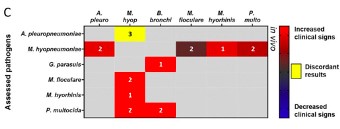
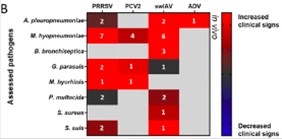
Figures 3 and 4 - Interactions between pathogens and the impact on clinical signs observed (Source: Saade et al., 2020)
Impact on performances
M.hyopneumoniae is known to be one of the most prevalent swine pathogens worldwide, causing substantial economic losses within the swine industry (Maes et al., 2018). The economic impact primarily derived from the decreased performance in production parameters, including a reduced average daily gain (ADG), reduced feed conversion ratio (FCR), increased mortality and an increase in use of antibiotics to control EP, as well as other pathogens involved in the PRDC (Maes et al., 2008). Straw et al. (1989) demonstrated that pneumonia due to M.hyopneumoniae caused a decrease in ADG and feed efficiency by 17% and 14% respectively. This is reflected in increased days to slaughter, therefore increasing cost of production.
Calculating the economic impact due to M.hyopneumoniae specifically is difficult to estimate due to the contribution of numerous co-infections (Maes et al., 2018The cost has been shown to be higher if other respiratory pathogens such as PRRS or SIV are also present along with M.hyopneumoniae (Haden et al., 2012). A recent study has demonstrated that the severity of the impact on productive performance, and therefore economic losses, is correlated with the percentage of lung consolidation caused by M.hyopneumoniae, reporting a negative correlation between lung consolidation lesions and ADG, where a 1% increase in lesion area corresponded to a decrease of 1.8g (Ferraz et al., 2020). Therefore, these few studies are similar in the economic impact of M.hyopneumoniae noted, however, it is important to remember that this value will always depend on the extent and severity of lesions.
Control and vaccination
Management practices
Management practices should be implemented to aid reduction in the impact of M.hyopneumoniae on farms. Methods include practising all-in-all-out systems (Maes et al., 2008) to allow for adequate cleaning and disinfection which will help to reduce the bacterial load in the environment before new animals enter the accommodation. Action should be taken to avoid any practices which may affect the immunological stability of the herd, such as buying in infected gilts or other live animals (Maes et al., 2001). Stocking density has also been shown to be important in the case of some respiratory diseases, with increased stocking densities having a negative impact on respiratory health (Maes et al., 2000). Therefore, the correct balance should be found in terms of maximising the use of accommodation for production and the stocking level which does not dramatically impact animal health (Maes et al., 2008).
Slaughterhouse evaluation
Examination of lungs in the slaughterhouse is a very valuable tool to veterinarians and farmers as it allows an assessment of the impact of EP on the farm in terms of performance and consequently the economic losses. Innovative technology has made the process easier, for example the Ceva Lung Program (CLP), which can be used on a smartphone or tablet in the slaughterhouse. CLP consists of the modified Madec method for scoring enzootic pneumonia-like lesions (Madec and Kobisch, 1982). Cranio-ventral consolidation of the lungs is scored from 1-4 for each lobe, with a maximum possible score of 28 per lung. The enzootic pneumonia index (EP index) can then be calculated, which is the sum of all scores per batch of pigs examined, divided by the total number of lungs scored. The app generates immediate reports with the key information such as percentage of bronchopneumonic lungs and EP index for pneumonia assessment, which can then be used by the veterinarian as part of their quarterly farm visit. Examination should be carried out frequently to get maximal benefit from the data collected, as seasonal variation may alter the prevalence of lesions observed for example, and this may result in incorrect interpretation of the success of control of M.hyo on a farm. Examination of lungs is very useful when implementing new control measures, as a reduction in lung lesions in the slaughterhouse is an important indication that clinical disease is reducing in both prevalence and severity.
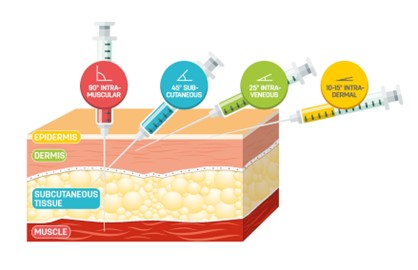
Correct angles of vaccination
Vaccination success
Vaccination is commonly used at weaning to control EP and has been shown to improve the daily weight gain by 2-8% and the feed conversion ratio by 2-5%, therefore reducing losses due to EP (Segales et al., 2008). Vaccination with an efficient vaccine has been shown to be effective at reducing both the percentage of pigs with EP-like lesions but also the severity of these lesions, as demonstrated by the Madec index which is calculated using a modified Madec score. The Ceva Lung Program (CLP) is a tool for analysis of the lungs in the slaughterhouse and has been used in many swine producing countries to demonstrate these reductions. Vaccination is also associated with reduced use of antimicrobials to control disease (Maes et al., 2008) contributing to achieving targets in reducing antimicrobial use across the industry.
Conclusion
Mycoplasma hyopneumoniae, as the causative agent of Enzootic Pneumonia, is an important pathogen on swine farms worldwide, affecting animal performance and therefore economic efficiency of production. Co-infections with other pathogens such as swine influenza virus, PRRS and PCV2 are extremely important as they can greatly increase the clinical and performance impacts of M.hyopneumoniae infection. Economic losses are primarily due to reduced average daily gain, contributing to increased days to slaughter, and increased feed conversion ratio, therefore increasing feed costs on the farm. Vaccination has been demonstrated to be effective in reducing the losses due to M.hyopneumoniae infection, working to reduce the lung lesion prevalence and severity, which has shown to be correlated with production losses. Therefore, vaccination combined with good management practices will help to reduce the impact of the pathogen as well as co-infections on farms.
Scientific References available on request
